|
ON THIS PAGE
Emphasis Mine In Bible Verses
Note Nebuchadnezzar's dream of a statue made from various metals (Daniel 2), Daniel's vision of the four beasts that came up from the sea. (Daniel 7), John's vision of a beast that came up from the sea. (Revelation 13), and the seven kings in Revelation 17:9-10 Are ALL Related.
 See Comparison Chart (On a Dragon and Two Beasts) See Comparison Chart (On a Dragon and Two Beasts)
The First Six Kings
Five Are Fallen
One Is
"The Other Is Not Yet Come"
The European Union?
Daniel Sets the Stage
The Two Legs of Iron
Iron Mixed With Miry Clay
The First Six Kings
John's vision in Revelation chapter 17 centered around a woman called the "great harlot" who sat on many waters. She was richly dressed in purple and scarlet, bedecked with much jewelry and was sitting upon a scarlet-colored beast that had seven heads and ten horns. Her forehead was labeled "Babylon the great, the mother of harlots and of the abominations of the earth". She held a gold cup full of abominations, and was drunk with the blood of the saints and with the blood of the witnesses of Jesus (V. 1-6). Eventually, she was turned on and destroyed by the beast and his allies (V.16).
The woman is identified as "the great city, which reigns over the kings of the earth". As shown in an earlier chapter (SEE) the "great city" is probably symbolic for all the spiritual apostasy (harlotry) that has taken place over the centuries, beginning in Babylon and culminating in today's New Age, goddess worship, Islam etc. See From Babel to Babylon To say nothing of the apostasy in the church. See The Contemporary Church
In verse 5, the harlot is called the "Mother of Harlots and of the Abominations of the Earth", which indicates that all spiritual apostasy stems from her. The "many waters" is defined in V. 15 as "peoples, and multitudes, and nations, and tongues", both of which quite clearly points to a global influence. However the puzzle does not quite end here, because the woman that John saw was sitting on a scarlet beast that had seven heads and ten horns which was explained thus by an angel
And the angel said to me, "Why do you wonder? I will tell you the mystery of the woman and of the beast that carries her, which has the seven heads and the ten horns.... Here is the mind which has wisdom. The seven heads are seven mountains on which the woman sits, and they are seven kings; five have fallen, one is, the other has not yet come; and when he comes, he must remain a little while. "The beast which was and is not, is himself also an eighth and is one of the seven, and he goes to destruction. (Revelation 17:7, 9-11 NASB)
The seven heads of the beast are symbolic of seven kings. At the time of writing, five of these kings had already fallen, one was in existence, and the other had not yet come. The beast itself is an eighth kingdom which is, in some way, one of the seven. So what kings or kingdoms are being described here? Note: "Kings" could well be interpreted as heads of government or world leaders in the modern world,.
"Five Are Fallen"
The five fallen kingdoms could very well refer to Egypt, Assyria, Babylon, Medo-Persia and Greece, all of which are long gone. At least four of these kingdoms were responsible for the spilling of much Jewish blood.
1.) The Egyptians:
Before Moses led the nation out of Egypt, the Romans had enslaved the entire nation and Herod had tried to kill all male babies.
2.) The Assyrians
Israel or the Northern Kingdom made up of 10 of the tribes (excluding Judah and Benjamin), was overrun by the Assyrians in 722 BCE. Much of the population was deported, although some are said to have fled south to Judah and Egypt.
3.) The Babylonians
The Babylonian king, Nebuchadnezzar, laid siege to Jerusalem itself for over a year, killed many people, destroyed the temple and left Jerusalem in ruins. He also took captive many thousands of Jews, including the prophets Daniel and Ezekiel. He came as close as it were possible to destroying the nation.
4.) Medo-Persia
The ancient prophet Isaiah prophesied that the Medes and the Persians would overtake the Babylonian Empire... "Behold, I am going to stir up the Medes against them, who will not value silver or take pleasure in gold... and Babylon, the beauty of kingdoms, the glory of the Chaldeans' pride, will be as when God overthrew Sodom and Gomorrah". (Isaiah 13:17,19 NASB). Jeremiah said the the spirit of the kings of the Medes was aroused by the Lord as vengeance for what the Babylonians did to his temple (Jeremiah 51:11 NASB).
It was during Medo-Persian rule that King Cyrus decreed that the Jews be allowed to to return to Jerusalem and rebuild God's temple. The Biblical story is corroborated by the the Cyrus Cylinder unearthed from the foundations of the Esagila, a Babylonian temple devoted to Marduk. See The Cyrus Cylinder on THIS page. However, the Persian empire was defeated by the Greeks in 331 B.C
5.) The Greeks
Alexander the Great was undefeated in battle and is widely considered one of history's most successful military commanders whose empire stretched across three continents from the Adriatic Sea to the Indus River, covering some two million square miles.
However, after his death in 322 BCE, his generals divided the empire between them. Judea was eventually incorporated into the Seleucid Kingdom ruled over by Antiochus IV Epiphanes from 175 BC until his death in 164 BC. At first, relations between the Seleucids and the Jews were cordial, but later on as the relations between the hellenized Jews and the religious Jews deteriorated, Antiochus decided to side with the Hellenized Jews by outlawing Jewish religious rites and traditions kept by observant Jews and by ordering the worship of Zeus as the supreme god (2 Maccabees 6:1–12).
The temple was filled with debauchery and reveling, and the altar was covered with abominable offerings which were forbidden by the laws. A man could neither keep the Sabbath nor observe the feasts of his fathers, nor so much as confess himself to be a Jew. Antiochus IV forbade burnt offerings and sacrifices and drink offerings in the sanctuary, ordered them to "profane Sabbaths and feasts, to defile the sanctuary and the priests, to build altars and sacred precincts and shrines for idols, to sacrifice swine and unclean animals, and to leave their sons uncircumcised" (1 Maccabees 1:45-48)
This sparked a national rebellion led by Judas Maccabeus. The Maccabean Revolt (174–135 BC), whose victory is celebrated in the Jewish festival of Hanukkah, is retold in the Books of the Maccabees. [FootnoteI]
6.) "One Is"
The sixth kingdom was the Roman empire, which at the time of writing was the ruling kingdom. The Romans militarily occupied Israel in 63 B.C., their rule growing increasingly oppressive. Caligula even declared himself to be a deity and ordered his statue to be set up in every temple in the Roman Empire, which the Jews refused to do. However, the Roman procurator Florus Gessius stealing money from the Temple treasury was a tipping point for the Jews who revolted however, the Romans breached the walls of Jerusalem and, in the ensuing violence, it is estimated that as many as one million Jews died. Shortly thereafter, the Romans destroyed the Second Temple.
7.) "The Other Is Not Yet Come"
The European Union?
There are many reasons to believe that the kingdom that had not yet come is the revived Roman empire, which in John's time was very much in the future, but may very well be coming into power in our day. However, when it does, it will only "remain a little while".
For a long time now, many have been convinced that these prophecies are today being fulfilled in Europe, and that the rebirth of the Roman Empire has taken place in the form of the European Union, a unique economic and political partnership, that was created in the aftermath of the Second World War to foster economic cooperation. It is presently comprised of 27 European countries that collectively cover much of the continent.
That the European Union has major spiritual implications is reflected in the symbols that it has adopted in the form of its flag, its anthem, its architecture, and its basic logo. For example,
.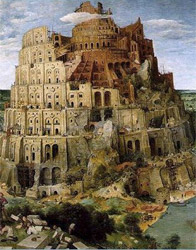 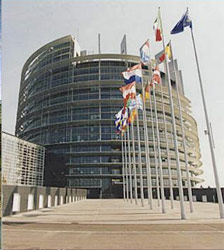
The New Tower of Babel: The city of Strasbourg (France) is the official seat of the European Parliament.
Although it looks unfinished, the Parliament building (right) was apparently designed to resemble a 1563 painting done of the partially constructed tower of Babel, by Pieter Brueghel the Elder - a Flemish Northern Renaissance Painter (left). Even the secular press could not miss the connection between the old and new towers of Babel. They labeled the new French structure "The Tower of Eurobabel."
And this was certainly not all.
An EU poster, known as 'the construction site poster', showed a building that was almost identical to the original Pieter Brueghel painting. The only changes were the addition of a crane and the EU twelve stars. (The European flag features a circle of 12 gold stars on a blue background? See Footnote II for some background)
The Woman Riding a Beast
Even more interestingly, the symbol of 'a woman riding a beast' is often used to represent the EU. While there is little question that the source of this symbol is an ancient legend featuring Zeus and Europa (for whom the continent Europe was named) and the story of her abduction by Zeus in the form of a bull, the similarity to John's vision in Revelation 17:3 cannot be ignored.
as a sculpture outside the EU office in Brussels, Belgium
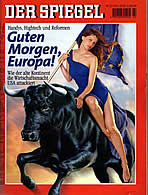
On the cover of the May 2000 Der Spiegel Magazine
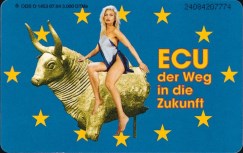
On a German phone card
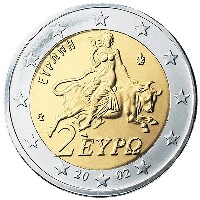 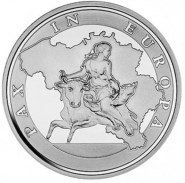
On various 2 Euro coins. These were issued in Greece and Belgium
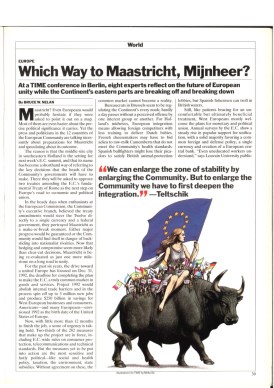
An article entitled Which Way to Maastricht, Mijnheer? in the 9th December 1991 Time magazine depicted a women riding a bull and holding aloft the European flag. [01]
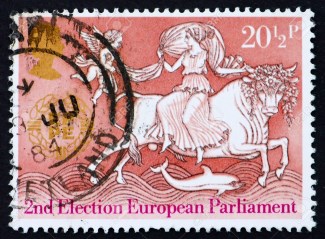
On a stamp issued in Great Britain to commemorate the first European Parliament elections in 1979
8) "And The Beast That Was, And Is Not, Is Himself Also An Eighth, And Is Of The Seven"
This is perhaps the most difficult part to understand. While it is clear that the beast will be an eighth kingdom, the fact that it will at the same time remain part of the seven, could very well mean that this eighth kingdom could in some way share something in common with the others who were violently opposed to the people of God, and tried their best to exterminate them.
Daniel Sets the Stage
The Bible is an integrated whole representing from cover to cover the 'whole counsel of God'. This is nowhere more apparent that when one compares John's vision of the Woman with Daniel's dreams and prophecies.
Daniel 2: Nebuchadnezzar's Dream
Many hundreds of years before John had his vision on the island of Patmos, Nebuchadnezzar, who was king of Babylon from approximately 605 BC to 562 BC, had a dream which greatly disturbed him. However, he apparently could not remember the details of this dream, and called for the sorcerers and magicians of the land, demanding that they tell him both what he had dreamed and what it meant. If they could not, he said, they would be executed.
Quite obviously, this was completely beyond the 'wise men' of the court, who told the king that only the gods could do what he asked. At which Nebuchadnezzar gave orders to destroy all of them, including Daniel and his friends who had been taken captive when the Babylonians ransacked Judah and who had, since then, gained the king's trust. Daniel requested time to fulfill the king's order, which was granted him. To cut a long story short, having found favor with God, the mystery was revealed to Daniel in what the Bible called a 'night vision', and he was able to tell the king the content and significance of his dream.
In summary, the king had dreamt of an enormous statue that had a head of fine gold. Its chest and arms were made of silver, the belly and thighs of bronze, and the legs of iron. The feet were a mix of iron and clay. But then, as King Nebuchadnezzar watched, a stone cut "without hands" out of a mountain, struck the image on its feet and crushed them, along with the rest of the statue. In Daniel's words...
Then the iron, the clay, the bronze, the silver and the gold were crushed all at the same time and became like chaff from the summer threshing floors; and the wind carried them away so that not a trace of them was found. But the stone that struck the statue became a great mountain and filled the whole earth. (Daniel 2:35 NASB)
The interpretation of the dream as given Daniel was this... Babylon itself was represented by the statue's golden head. However, three more kingdoms would arise in turn after Babylon. The second kingdom would be inferior to Babylon, and it would be followed by a third kingdom of bronze, which would rule over all the earth. The fourth kingdom would be as strong as iron... crushing the others.
History has proven Daniel right....
Babylon was overthrown by the Medes and the Persians, which parallels the statue's breast and arms of silver.
The Greeks under Alexander the Great, represented by the bronze torso and thighs, conquered the Medo/Persian Empire.
The Roman Empire, represented by the two iron legs of the statue, took over as the dominant world power as the Grecian city states began to decline. The Battle of Corinth in 146 BC marked the beginning of Roman domination. What is truly significant is the fact that, many years later, the Roman emperor Diocletian [284-305] split the empire in half, creating what would become the Western Roman Empire and the Eastern Roman Empire, i.e. the two legs of the statue. However the fourth kingdom (the Roman Empire) did not end at the legs of the statue, but merged down into the feet and toes. The ten toes have a symbolism which I will come to later.
In summary, Daniel interpreted Nebuchadnezzar's dream as four great kingdoms that, in succession, would dominate history. However, in the final scene, the entire statue is reduced to dust by a rock that becomes a mountain and fills the earth. This rock represents God's kingdom, which starts out small, but expands until it fills the earth, destroying all man made kingdoms in the process.
See The Three Stage Emergence of The Kingdom and What And Where is Heaven?
Daniel 7: Four Great Beasts
Years later, Daniel himself had a very unusual and highly disturbing dream (a night vision) in which he saw our four great beasts, completely different from one another, come up from the sea.
The first was like a lion with eagle's wings
The second as like a bear that devoured much flesh
The third like a four-headed leopard with four wings
The fourth was described as terrible and exceedingly strong, with great iron teeth and ten horns.
Daniel was told that the four beasts "are four kings who will arise from the earth" (V. 17) and that
"...The fourth beast will be a fourth kingdom on the earth, which will be different from all the other kingdoms and will devour the whole earth and tread it down and crush it." (Daniel 7:23 NASB) For Details See A Dragon and Two Beasts
Which should make it obvious that, although Nebuchadnezzar's dream and John’s vision of the beasts that came up from the sea record different details, both referred to the same series of events ie. the successive rise of four empires... Babylon, Medo-Persia, Greece and Rome, which finally give way to the Kingdom of God.
In other words, Daniel and John were talking about the same seven kingdoms, except that Daniel prophesied during the Babylonian reign and did not mention kingdoms that were already past. (Every man on the street probably had some knowledge about those). Instead, Daniel showed himself to be a true prophet of God by foretelling kingdoms yet to come - something that no human could possibly do. Daniel's prophecies started in his day, then continued many centuries into the future from Babylon to the return of our Lord when the saints would possess the kingdom (Daniel 7:18).
However, Revelation has a different point of view often presenting a sweeping overview of thousands of years of history in one or two short paragraphs. When John wrote “ The seven heads are seven mountains on which the woman sits, and they are seven kings; five have fallen, one is, the other has not yet come” he was reaching far back into time and referring to ALL the major world empires up to the time of Rome, that came into direct contact with and usually opposed Israel. He then looked forward to the seventh kingdom and the ten kings.
The Two Legs of Iron.
When Daniel was given the interpretation of the king's dream all that was said about the iron legs (Rome) was that its feet were partly made of iron and partly of clay (Daniel 2:33).
The two legs are easy to understand. As mentioned, the emperor Diocletian divided the Roman empire into East and West in 285 A.D. However there is more to the story. Bearing in mind that since the Roman Empire is symbolized by two legs, it stands to reason that both have a role to play in end time prophecy.
The question being where both legs of the statue are today.
Rome ceased to be the capital after the Empire was divided. Mediolanum (modern Milan) was initially the capital of the Western Roman Empire however, emperor Constantine who adopted Christianity in 312, established the capital of the Eastern Roman Empire at an ancient Greek city called Byzantium. He renamed it Constantinople (Constantinopolis) or "Constantine's City". However, the Eastern Roman Empire was commonly called the Byzantine Empire.
The Western Empire
did not last very long after the division in 286 AD by the Emperor Diocletian. In due course the barbarians overran the Empire and the emperors retreated to Ravenna. The western half of the empire finally collapsed in the 5th century and never rose again, despite some attempts by the Eastern Empire to revive it. Emperor Justinian envisioned a reunified Roman Empire, and in pursuit of that dream was able to capture not only Italy, but also Spain and the Aegean coast, almost reestablishing the Roman Empire's borders before it moved north of the Alps.
However, these wars progressively weakened the Byzantium Empire and, soon after Justinian's death, Germanic tribes from the north recaptured most of the territory that had been re-taken by Justinian. Eventually the Lombards invaded the peninsula in such numbers that only Sicily and parts of southern Italy were left under Eastern Roman rule.
The Western Roman Empire is relatively easy to trace since it covered most of western Europe including France, Spain and Italy, plus north Africa and Greece. In fact Kaiser, the German title meaning Emperor, usually reserved for the Emperors of the German Empire, the Austrian Empire, and the Austro-Hungarian Empire, is directly derived from the Latin Emperors' title of Caesar.
The Eastern Empire
on the other hand is not as easy to trace. It outlived the west by some 1000 years. While Western Europe was in tatters, occupied by the Franks, Visigoths, Ostrogoths and Vandals, the largely Greek speaking Eastern Empire was a leading center of the world's civilization, ruled by a succession of emperors based in the capitol Constantinople.
It was a prosperous city populated by Greeks, Armenians, Syrians etc and attracted diplomats, merchants, sailors and other travelers from many parts of the globe. All this came to an end when after centuries of Byzantine-Arab Wars the Ottoman Turks under the command of Sultan Mehmed II overran the city in 1453 after a two-month siege. Mehmed killed the last emperor Constantine XI, formally marking the end of the Eastern Roman Empire.
Down through history, the Roman Empire has continued as two legs. The Western leg consists of most of a large part of modern Europe, while the Eastern leg is probably continued in the Turks and/or the Russians. Here are the arguments for each.
The Ottoman Empire: Since Byzantium was considered the continuation of the Roman Empire, or the "Second Rome", the fall of Constantinople led competing factions to lay claim to being the "Third Rome" Sultan Mehmed twice ruler of the Ottoman Empire was famous for ending the Byzantine Empire by capturing Constantinople in 1453 and and declared himself Kayser-i Rum... literally "Caesar of Rome".
The Russians: The other noteworthy claimant to Byzantine heritage was a Russian. Nineteen years after the fall of Constantinople, a marriage was arranged between Ivan the Great, Duke of Muscovy, and Zoe, niece of the last emperor of Byzantium who changed her name to Sophia. The marriage passed the responsibilities of defender of the Orthodox faith onto Ivan III. Not only did Sophia introduce Byzantine court life to Moscow, but Ivan the Great took the title Tsar (or Czar), which is also derived from the Roman word Caesar. He also adopted as Russia's symbol the double-headed eagle... a symbol of Byzantium.
The case for the Eastern Roman Empire trickling down through the Turks is far stronger. The Russian claim is based solely on the marriage of one woman, whereas the Byzantine Empire was literally absorbed into the Ottoman Empire. After the defeat of Constantinople, not only did the Greek Orthodox Church remained intact, but many villages, specifically along the land walls, were allowed to keep their churches and form self-governing communities in the multi national Ottoman Empire. In essence, the Ottoman Empire became a continuation of both Greco-Roman and Islamic cultures.
And where is the Ottoman Empire today?
The modern Republic of Turkey is the successor state to the Ottoman Empire. Constantinople was re-named Istanbul in 1930, when Turkey emerged as a new nation that, even today, has a reputation for being a cultural and ethnic melting pot. Even the hamam or Turkish bath was a Roman/Byzantine tradition, adopted, then perfected by the Turks.
Turkey and The EU
Giving credence to the theory that modern day Turkey is the successor to the Eastern Roman Empire is the fact that Turkey has been an associate member of the European Union (EU) and its predecessors since 1963. Also, after the ten founding members, Turkey was one of the first countries (the 13th) to become a member of the Council of Europe in 1949. Turkey's application to accede to the European Union (previously the European Communities) was made on 14 April 1987, and it was first officially recognized as a candidate for full membership at the Helsinki summit of the European Council in December 1999.
Although problems have arisen including Turkey's 1980 military coup, it's human rights record, the relative underdevelopment of Turkey's economy, the dispute with Greece over the island of Cyprus, and fears of Islam, should Turkey actually become a full fledged member of the EU, it would be the first Muslim-majority country to join the European Union. According to a 2009 article in Time Magazine
President Nicolas Sarkozy and German Chancellor Angela Merkel, both said that Turkey can never be allowed to join the E.U. The two leaders came to power after the E.U.'s unanimous decision in 2004 to formally start accession talks with Turkey. But they instead talk of Turkey having a "privileged relationship" with the E.U. rather than full E.U. membership. [02]
Perhaps the one leg of Daniel's statue is seeking to be 'reunited' with the other, an event which, if it happens, will certainly signal the rebirth of the Roman Empire and quite possibly lead to the emergence of the antichrist. Or perhaps, a "privileged relationship" will be sufficient.
Iron Mixed With Miry Clay
Some disagree with the idea that Daniel's fourth beast represents the Roman Empire because the Romans did not devour the whole earth (much as they tried to), nor did their empire break the earth in pieces. However, we need to remember that the Roman Empire did not stop with the iron legs of Nebuchadnezzar's image, but continued into the ten toes which were only partially made of iron.
This brings up another grim dimension in the form of Daniel's unusual, but highly significant statement regarding the image in Nebuchadnezzar's dream. I am quoting the ancient prophets words as rendered by three different translations.
And in that you saw the iron mixed with common clay, they will combine with one another in the seed of men; but they will not adhere to one another, even as iron does not combine with pottery. (Daniel 2:43 NASB)
And whereas thou sawest iron mixed with miry clay, they shall mingle themselves with the seed of men: but they shall not cleave one to another, even as iron is not mixed with clay. (Daniel 2:43 KJV)
Because thou hast seen iron mixed with miry clay, they are mixing themselves with the seed of men: and they are not adhering one with another, even as iron is not mixed with clay. (Daniel 2:43 YLT)
Some commentators have taken this to mean racial intermingling. Others, the mix of powerful and weak men in the empire, or even matrimonial alliances. Yet others have completely ignored the verse. But the crux of the matter is what or whom is represented by 'clay' the only non-metallic part of the statue. Daniel uses the personal pronoun "they"... They shall mingle themselves with the seed of men...". The phrase certainly indicates that whoever or whatever it is that will 'mingle with the seed of men' are not the seed of men themselves
it seems very likely that the Bible is harking back to the days of Noah, when the unholy union of the supernatural with the natural caused God to destroy almost everyone on the earth. Not at all an unlikely scenario considering this last part of Daniel's vision takes place in the very end times before God's rock destroys the kingdoms of man and Satan.
In fact, the Bible tells us that in the days immediately preceding the return of Jesus Christ we shall find similar conditions to the days of Noah. Our Lord Himself linked these two epochs together and said that one is the parallel of the other.
For the coming of the Son of Man will be just like the days of Noah. (Matthew 24:37 NASB)
And just as it happened in the days of Noah, so it will be also in the days of the Son of Man: (Luke 17:26 NASB)
And what does Scripture say about those days?
... the sons of God came unto the daughters of men, and they bare children to them: the same were the mighty men that were of old, the men of renown. [See Genesis 6:1-4].
They shall "mingle themselves with the seed of men"... Is this verse prophesying the return of the Nephilim? [See Days of Noah]
Additionally, the comparisons between Daniel and John do not end here... See A Dragon and Two Beasts
Footnote I... Excerpt From Maccabees
When these happenings were reported to the king, he thought that Judea was in revolt. Raging like a wild animal, he set out from Egypt and took Jerusalem by storm. He ordered his soldiers to cut down without mercy those whom they met and to slay those who took refuge in their houses. There was a massacre of young and old, a killing of women and children, a slaughter of virgins and infants. In the space of three days, eighty thousand were lost, forty thousand meeting a violent death, and the same number being sold into slavery.” (2 Maccabees 5:11–14)
He plundered the city, burned it with fire, and tore down its houses and its surrounding walls.... "He arrogantly entered the sanctuary and took the golden altar, the lamp stand for the light, and all its utensils. He took also the table for the bread of the Presence, the cups for drink offerings, the bowls, the golden censers, the curtain, the crowns, and the gold decoration on the front of the temple; he stripped it all off. He took the silver and the gold, and the costly vessels; he took also the hidden treasures which he found"... (1 Maccabees 1:21-23, 31) [PLACE IN TEXT]
Footnote II... The European flag, Strasbourg Cathedral and Mary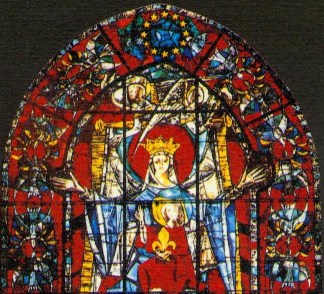
The European flag features a circle of 12 gold stars on a blue background. It was designed by Arsène Heitz who was supposed to have later revealed that his inspiration was the crown of twelve stars of the Woman of the Apocalypse, often found in Marian iconography. While this may or may not be true, Heitz was a French Catholic who was born and raised in Strasbourg, and the stained glass window above the main altar in Strasbourg Cathedral depicts the Virgin Mary crowned with 12 Stars. (Picture on right).
Therefore, whether he admitted it on not, and no matter how loudly the powers that be claim that neither the color of the flag nor the stars are meant to be religious symbols, I have little doubt that the inspiration for his design came from the cathedral.
Roman Catholic art that commonly depicts Mary as standing on a crescent moon with twelve stars around her head stems from Revelation chapter 12:1 that describes depicts a woman "clothed with the sun, and the moon under her feet, and on her head a crown of twelve stars". The next few verses go on to say...
(2) and she was with child; and she *cried out, being in labor and in pain to give birth. (3) Then another sign appeared in heaven: and behold, a great red dragon having seven heads and ten horns, and on his heads were seven diadems. (4) And his tail swept away a third of the stars of heaven and threw them to the earth. And the dragon stood before the woman who was about to give birth, so that when she gave birth he might devour her child. (5) And she gave birth to a son, a male child, who is to rule all the nations with a rod of iron; and her child was caught up to God and to His throne. (6) Then the woman fled into the wilderness where she had a place prepared by God, so that there she would be nourished for one thousand two hundred and sixty days. (Revelation 12:21-6 NASB)
Opinions vary greatly as to the identity of the woman portrayed in John's account. Catholics believe that she is the Virgin Mary, while most Protestants tend to believe the woman is a symbolic reference to Israel. Others identify the woman as the church.
The problem is that none of these opinions are without merit, and none of them are without problems. See The Woman of Revelation 12 which is part of the article Mary, Queen of Heaven? [PLACE IN TEXT]
Endnotes
[01] http://time.com/vault/issue/1991-12-09/page/41/
[02] Leo Cendrowicz / Brussels. Fifty Years On, Turkey Still Pines to Become European
http://content.time.com/time/world/article/0,8599,1920882,00.html
|